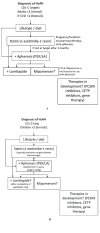Identification and Treatment of Patients with Homozygous Familial Hypercholesterolaemia: Information and Recommendations from a Middle East Advisory Panel
- PMID: 26311574
- PMCID: PMC4997916
- DOI: 10.2174/1570161113666150827125040
Identification and Treatment of Patients with Homozygous Familial Hypercholesterolaemia: Information and Recommendations from a Middle East Advisory Panel
Abstract
We present clinical practice guidelines for the diagnosis and treatment of homozygous familial hypercholesterolaemia (HoFH) in the Middle East region. While guidelines are broadly applicable in Europe, in the Middle East we experience a range of confounding factors that complicate disease management to a point whereby the European guidance cannot be applied without significant modification. Specifically, for disease prevalence, the Middle East region has an established epidemic of diabetes and metabolic syndrome that can complicate treatment and mask a clinical diagnosis of HoFH. We have also a high incidence of consanguineous marriages, which increase the risk of transmission of recessive and homozygous genetic disorders. This risk is further augmented in autosomal dominant disorders such as familial hypercholesterolaemia (FH), in which a range of defective genes can be transmitted, all of which contribute to the phenotypic expression of the disease. In terms of treatment, we do not have access to lipoprotein apheresis on the same scale as in Europe, and there remains a significant reliance on statins, ezetimibe and the older plasma exchange methods. Additionally, we do not have widespread access to anti-apolipoprotein B therapies and microsomal transfer protein inhibitors. In order to adapt existing global guidance documents on HoFH to the Middle East region, we convened a panel of experts from Oman, Saudi Arabia, UAE, Iran and Bahrain to draft a regional guidance document for HoFH. We also included selected experts from outside the region. This panel statement will form the foundation of a detailed appraisal of the current FH management in the Middle Eastern population and thereby provide a suitable set of guidelines tailored for the region.
Figures




Similar articles
-
Homozygous familial hypercholesterolaemia: new insights and guidance for clinicians to improve detection and clinical management. A position paper from the Consensus Panel on Familial Hypercholesterolaemia of the European Atherosclerosis Society.Eur Heart J. 2014 Aug 21;35(32):2146-57. doi: 10.1093/eurheartj/ehu274. Epub 2014 Jul 22. Eur Heart J. 2014. PMID: 25053660 Free PMC article.
-
[Homozygous familial hypercholesterolaemia: Spanish adaptation of the position paper from the Consensus Panel on Familial Hypercholesterolaemia of the European Atherosclerosis Society. Consensus document of the Spanish Society of Arteriosclerosis (SEA) and Familial Hypercholesterolaemia Foundation (FHF)].Clin Investig Arterioscler. 2015 Mar-Apr;27(2):80-96. doi: 10.1016/j.arteri.2015.01.002. Epub 2015 Mar 8. Clin Investig Arterioscler. 2015. PMID: 25757840 Spanish.
-
Modern approaches to the management of homozygous familial hypercholesterolemia in the Middle East and North Africa.J Clin Lipidol. 2024 Mar-Apr;18(2):e132-e141. doi: 10.1016/j.jacl.2023.12.003. Epub 2023 Dec 15. J Clin Lipidol. 2024. PMID: 38158247 Review.
-
Recommendations for the management of patients with homozygous familial hypercholesterolaemia: overview of a new European Atherosclerosis Society consensus statement.Atheroscler Suppl. 2014 Sep;15(2):26-32. doi: 10.1016/j.atherosclerosissup.2014.07.004. Atheroscler Suppl. 2014. PMID: 25257074 Review.
-
Homozygous familial hypercholesterolaemia: update on management.Paediatr Int Child Health. 2016 Nov;36(4):243-247. doi: 10.1080/20469047.2016.1246640. Paediatr Int Child Health. 2016. PMID: 27967828 Review.
Cited by
-
Dyslipidemia in the Arabian Gulf and its Impact on Cardiovascular Risk Outcome.Oman Med J. 2015 Nov;30(6):403-5. doi: 10.5001/omj.2015.81. Oman Med J. 2015. PMID: 26693273 Free PMC article. No abstract available.
-
The Genetic Spectrum of Familial Hypercholesterolemia (FH) in the Iranian Population.Sci Rep. 2017 Dec 6;7(1):17087. doi: 10.1038/s41598-017-17181-9. Sci Rep. 2017. PMID: 29213121 Free PMC article.
-
New Treatments on the Horizon for Familial Hypercholesterolemia.Oman Med J. 2017 Nov;32(6):447-448. doi: 10.5001/omj.2017.86. Oman Med J. 2017. PMID: 29218118 Free PMC article. No abstract available.
-
The Gulf Familial Hypercholesterolemia Registry (Gulf FH): Design, Rationale and Preliminary Results.Curr Vasc Pharmacol. 2020;18(1):57-64. doi: 10.2174/1570161116666181005125459. Curr Vasc Pharmacol. 2020. PMID: 30289081 Free PMC article.
-
Familial Hypercholesterolemia: A Systematic Review of Guidelines on Genetic Testing and Patient Management.Front Public Health. 2017 Sep 25;5:252. doi: 10.3389/fpubh.2017.00252. eCollection 2017. Front Public Health. 2017. PMID: 28993804 Free PMC article.
References
-
- Husseini A., Abu-Rmeileh N.M., Mikki N., et al. Cardiovascular diseases, diabetes mellitus, and cancer in the occupied Palestinian territory. Lancet. 2009;373(9668):1041–1049. - PubMed
-
- Gehani A.A., Al-Hinai A.T., Zubaid M., et al. Association of risk factors with acute myocardial infarction in Middle Eastern countries: the INTERHEART Middle East study. Eur. J. Prev. Cardiol. 2014;21(4):400–410. - PubMed
Publication types
MeSH terms
Substances
LinkOut - more resources
Full Text Sources
Other Literature Sources
Miscellaneous

